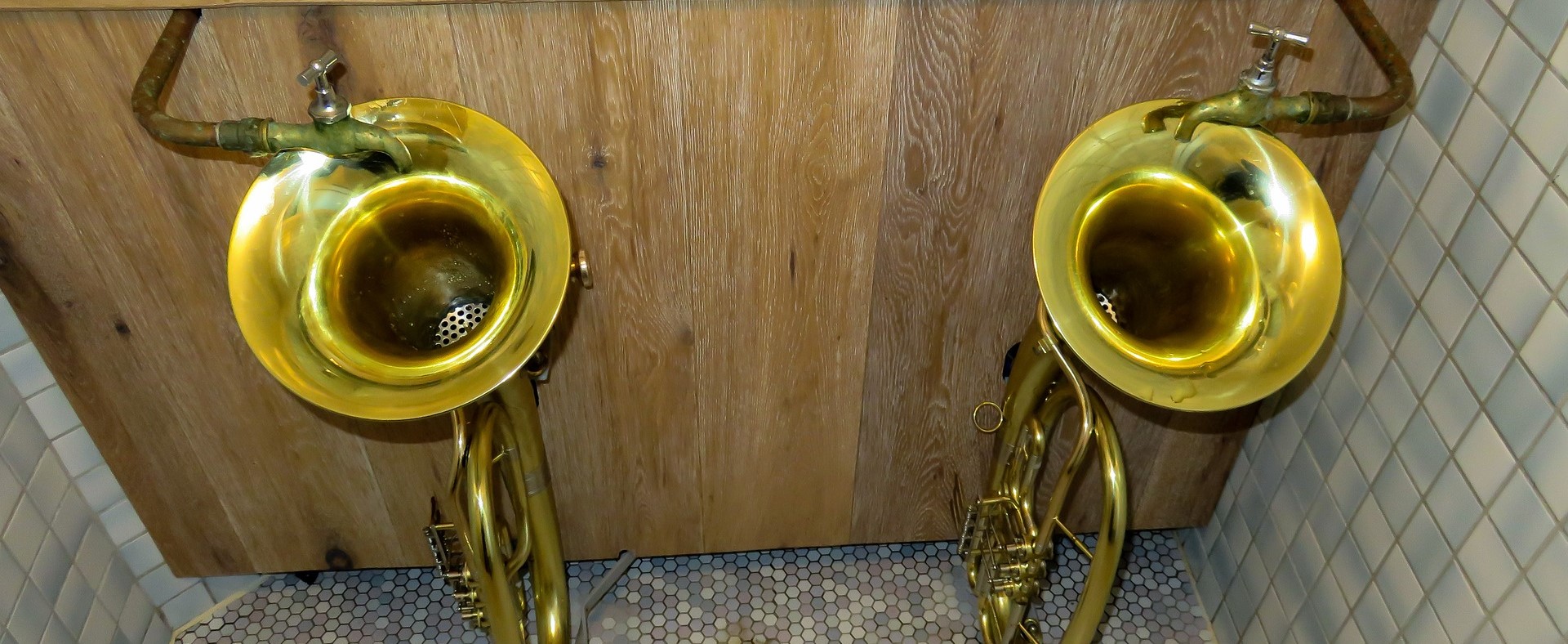Ella Cook @ella-cook
Author
Ella Cook
Thursday 11 April 2019
- 4 minute read
Let’s start with the basics…
A urinal is a sanitary plumbing fixture which can be with automatic or manual flushing, or without flush water as is the case for waterless urinals. They can be arranged as single sanitary fixtures (with or without privacy walls) or in a trough design without privacy walls.

In busy male washrooms, urinals are normally installed for efficiency as usage is faster and more sanitary because there are no germs, no doors or locks to touch, and no seat to turn up. A urinal takes up less space in the washroom, is simpler, and consumes less water per flush (or even no water at all) than a toilet.
Public urinals often have a plastic mesh guard, which may optionally contain a deodorizing urinal block or often known as a “urinal cake”. This intended to prevent solid objects (such as cigarette butts, chewing gum, or paper) from being flushed and possibly causing a plumbing stoppage.
What is a urinal supposed to do?
A urinal has 4 main parts:

The pan collects urine and directs it to the trap via a urinal spud. The water is used to “flush” it faster into the trap.
Urinals with flushing
Most public urinals incorporate a water flushing system to rinse urine from the bowl of the device, to prevent foul odors. The flush can be triggered by one of several methods:
Manual Flush: these are fairly standard. A lever is used to activate the flush. Some urinals use dual-flush handles. The flush uses half as much water when lever is pushed upwards, than otherwise. These urinals are pften marked green in color.
Timed Flush: These are also called as auto-cistern urinal flush. These operate automatically at timed intervals. The timing can be controlled hydraulically with pressure, or electronically. This is often used on trough designs as well, where the urine is systemtimatically washed away.
Sensor Flush: An infrared sensor identifies when the urinal has been used. It detects the person standing in front of the urinal and activates the flush when he has moved away. Different configurations are possible to save water.
Waterless Urinals
Waterless urinals can be installed in high-traffic facilities, and in situations where providing a water supply may be difficult or where water conservation is desired. The drain pipes from waterless urinals need to be installed correctly in terms of diameter, slope and pipe materials in order to prevent buildup of struvite (“urine stone”) and calcium phosphate precipitates in the pipes, which would cause blockages and could require expensive repairs. When maintained according to manufacturers’ recommendations, well-designed waterless urinals do not emit any more odors than flushed urinals do.

Pros of Waterless Urinals
Water Savings: In most facilities, more water is used in restrooms than any other area of the building. While most of this water is used for flushing toilets, water consumption used for flushing urinals is not far behind. While the annual amounts can vary depending on where the urinal is located, the frequency of use, the number of males in the facility, and other factors, waterless urinals can save anywhere from 30,000 gallons to 40,000 gallons of water per year, per urinal.
Low Maintenance: Urinals, whether they are water using or no-water urinals, are very hardy and durable and can last for years and years. However, the same cannot be said for the flush handles. In a restaurant, bar, or school, the flush handles frequently are tampered with or need service and maintenance just due to use and wear. Hard encrustation pipe clogging happens less often with waterless urinals. It is the mixing of water and urine in flushed urinals that causes encrustations to form in pipes. With the absence of water, only soft sediments remain.
Improved Hygiene: They stay dry, and we learnt at school that bacteria need moisture to grow and survive. Further, when a urinal is flushed, it can release airborne pathogens that can coat floors, walls, and land on people’s hands. This can result in cross contamination. And of course, there is the problem with touching the flush handle.
Odor Control: We mentioned earlier that bacteria need water to develop and survive. So do odors, typically released by the bacteria. This means fewer bacteria/less odor. We should also mention that with the Waterless system, a trap or cylinder is placed at the bottom of the urinal. Then it is filled with a sealant. This keeps sewer odors from being released into the restroom, further keeping the restroom clean and odor free.
Just a note - some clients request replacing the floor but keeping the cubicles and other sanitaryware installed. This will not get rid of bad smells, as the badly sealed edges around cubicles stands and basins etc. will help bacteria to grow and multiply.

Cons of Waterless Urinals
Resistance: There still remains some user resistance to using no-water urinals. When men realize how much water is being saved, any opposition to using waterless urinals soon dissipates. Some cleaning professionals are reluctant to remove the cylinder/trap at the bottom of the urinal. Because it is so crucial that these cylinders/traps be changed when necessary, some manufacturers have introduced specially designed tools to make the entire process as safe and easy as possible.
Retrofits: While many waterless urinals are designed to have the same footprint and convention water-using urinals, some adjustments may be necessary. For instance, in about 50 percent of retrofits, the drain pipe may need to be lowered for proper mounting height, especially if older flushed urinals were installed.
Improper Cleaning: Once waterless urinals have been installed in a facility, cleaning professionals are often not taught how to clean them properly. While it is not much different than cleaning a traditional urinal, too much water used in cleaning or the use of certain cleaning chemicals, for instance, can harm the cylinders/traps used in waterless urinals.
Ella Cook @ella-cook
Author